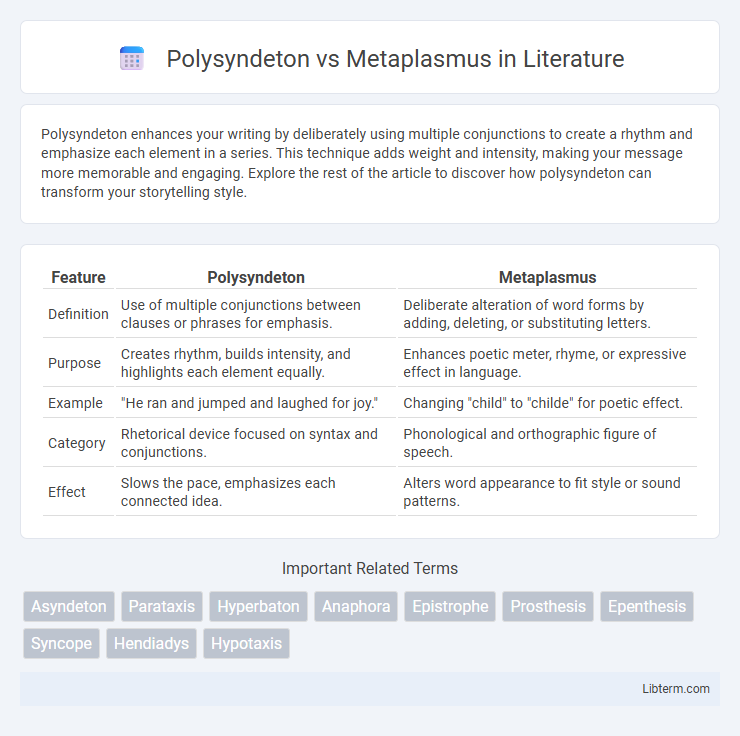Polysyndeton enhances your writing by deliberately using multiple conjunctions to create a rhythm and emphasize each element in a series. This technique adds weight and intensity, making your message more memorable and engaging. Explore the rest of the article to discover how polysyndeton can transform your storytelling style.
Table of Comparison
| Feature | Polysyndeton | Metaplasmus |
|---|---|---|
| Definition | Use of multiple conjunctions between clauses or phrases for emphasis. | Deliberate alteration of word forms by adding, deleting, or substituting letters. |
| Purpose | Creates rhythm, builds intensity, and highlights each element equally. | Enhances poetic meter, rhyme, or expressive effect in language. |
| Example | "He ran and jumped and laughed for joy." | Changing "child" to "childe" for poetic effect. |
| Category | Rhetorical device focused on syntax and conjunctions. | Phonological and orthographic figure of speech. |
| Effect | Slows the pace, emphasizes each connected idea. | Alters word appearance to fit style or sound patterns. |
Introduction to Polysyndeton and Metaplasmus
Polysyndeton is a rhetorical device characterized by the deliberate use of multiple conjunctions between clauses or words to create emphasis and rhythmic effect. Metaplasmus involves the intentional alteration of words through the addition, subtraction, or substitution of letters to achieve a specific phonetic or semantic effect. Both techniques enhance literary style by manipulating language structure, with polysyndeton emphasizing accumulation and metaplasmus focusing on word modification.
Defining Polysyndeton: Meaning and Usage
Polysyndeton is a rhetorical device characterized by the repetitive use of conjunctions between words, phrases, or clauses to create a deliberate rhythm and emphasize each element in a series. This technique enhances the impact of a sentence by slowing its pace and adding weight to each connected idea, often found in literary works, speeches, and persuasive writing. Polysyndeton differs from metaplasmus, which involves the alteration of word forms through adding, omitting, or rearranging letters for stylistic effects rather than conjunction repetition.
Defining Metaplasmus: Meaning and Variations
Metaplasmus is a rhetorical device involving the intentional alteration of a word's structure through addition, omission, or substitution of letters to create a stylistic or phonetic effect. Variations include aphaeresis (omission at the beginning), apocope (omission at the end), and epenthesis (addition within a word), each enhancing expressiveness or fitting metrical constraints. Unlike polysyndeton, which uses repetitive conjunctions to emphasize coordination, metaplasmus modifies word forms to impact pronunciation and meaning.
Historical Origins of Polysyndeton
Polysyndeton, a rhetorical device featuring the deliberate repetition of conjunctions, traces its origins to ancient Greek and Roman literature, where authors like Homer and Cicero employed it to enhance rhythmic effect and emphasize each element in a series. In contrast, Metaplasmus involves deliberate alterations in word forms to achieve phonetic or morphological effects, with roots in classical linguistic studies but serving different stylistic functions. The historical significance of polysyndeton lies in its role in epic poetry and oratory, where it contributed to a measured, solemn tone and underscored the weight of each successive idea.
Historical Development of Metaplasmus
Metaplasmus, a rhetorical device involving the alteration of word forms through addition, omission, or substitution, traces its origins to classical Greek and Latin literature, where authors like Homer and Virgil employed it to fit metrical constraints or enhance poetic effect. Over centuries, Metaplasmus evolved through medieval and Renaissance poetry, becoming a crafted technique to manipulate phonetics and morphology for artistic expression and mnemonic purposes. Unlike Polysyndeton, which emphasizes repetition of conjunctions to create rhythm and intensity, Metaplasmus focuses on morphological changes to enrich language and accommodate specific stylistic or structural demands.
Literary Functions of Polysyndeton
Polysyndeton enhances literary style by using multiple conjunctions to create a deliberate pacing, emphasizing each element in a series and often intensifying the emotional impact or rhythm of a passage. This technique fosters a sense of abundance or overwhelming detail, making the reader slow down and absorb the cumulative weight of the listed items. In contrast, metaplasmus involves altering word structures for phonetic or morphological effects, serving more as a stylistic device focused on language transformation rather than syntactical rhythm.
Literary Impact of Metaplasmus
Metaplasmus, the intentional alteration of words through insertion, omission, or substitution, shapes literary style by enhancing phonetic texture and evoking emotional resonance. This linguistic mutation deepens character voice and injects originality, distinguishing the text from conventional expression. Unlike polysyndeton's repetitive conjunctions that emphasize rhythm and accumulation, metaplasmus transforms language at the morphological level, amplifying narrative impact through innovative wordplay.
Key Differences: Polysyndeton vs Metaplasmus
Polysyndeton is a rhetorical device characterized by the deliberate use of multiple conjunctions between clauses or phrases to create emphasis and rhythm, often extending the sentence flow. Metaplasmus involves the intentional alteration of words through the addition, deletion, or substitution of letters to achieve a specific phonetic or stylistic effect in language. The key difference lies in Polysyndeton's focus on syntactic structure and conjunctions, while Metaplasmus centers on morphological changes within words to influence sound and meaning.
Examples of Polysyndeton and Metaplasmus in Literature
Polysyndeton, exemplified by Charles Dickens in "A Tale of Two Cities" with the repeated use of "and" in the phrase "and the men, and the women, and the children," intensifies the rhythm and emphasizes each listed element. Metaplasmus, a rhetorical device involving the intentional alteration of words, appears in Shakespeare's works, such as the contraction "o'er" for "over" in "Othello," enhancing poetic meter and emotional impact. Both devices serve distinct stylistic functions: polysyndeton builds cumulative effect through conjunctions, while metaplasmus modifies word form for phonetic or expressive purposes.
Choosing the Right Device: When and Why
Choosing between polysyndeton and metaplasmus depends on the desired impact on the audience; polysyndeton amplifies rhythm and intensity by inserting multiple conjunctions, creating a feeling of abundance or urgency. Metaplasmus, as a phonetic alteration involving the modification of word sounds, serves to emphasize or soften linguistic expression, often enhancing poetic or rhetorical subtlety. Writers select polysyndeton to slow down the pace and highlight each element, while metaplasmus suits nuanced wordplay or stylistic finesse.
Polysyndeton Infographic

 libterm.com
libterm.com